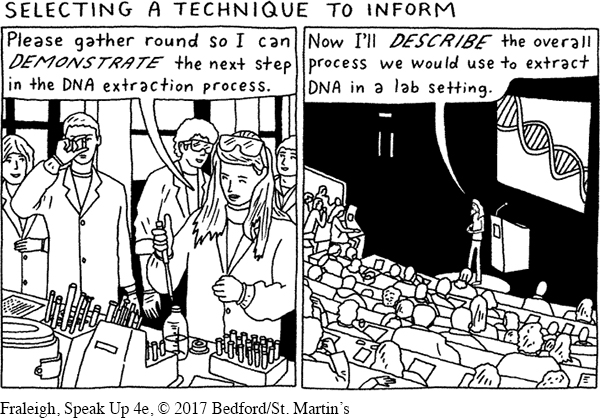Selecting a Technique
Your audience analysis also informs your choice of technique—
For example, suppose you were considering using demonstration to present your informative speech. In this case, you would want to ask yourself the following questions:
Forum: “Where will the audience be situated—
and will there be ample space for me to move around as I give my demonstration?” Audience size: “How many people will be in my audience—
and will they all be able to see and hear my demonstration?”
You also should consider audience size and details of the speaking forum when planning presentation aids for your informative speech. If you anticipate a small audience and cramped space, a PowerPoint presentation may be unnecessary. Showing objects or offering simple handouts might create an intimate setting. In a big forum with a large audience, you may be best served by projecting PowerPoint slides onto a large screen (or even several large screens) and adequately amplifying your voice. When speaking in such situations, make sure you plan carefully where you will stand. You may want to stand in the center of the room, directly before the screen or screens, and control the audience’s interaction with the presentation aids by making the screen go blank after each point is made.
Page 490

Conversely, let’s say you were considering using explanation or description to deliver your speech. In this case, you would focus more on demographics to analyze your audience. Look for anything in your listeners’ backgrounds and characteristics that may make it difficult for them to understand the explanation or description you’re planning to offer in your speech. For instance, if you’re planning to describe a Hmong wedding ceremony and your listeners have no knowledge of Hmong culture, you’ll need to provide more details in your description. Or if you’re planning to explain the events leading up to the assassination of U.S. president John F. Kennedy and your listeners are too young to have lived through the event, you’ll want to provide a fuller explanation than you would for an older audience. Of course, cultural background and age are not the only examples of demographics. You’ll also need to consider other characteristics to develop an effective informative speech.
What if you’re thinking about using narrative to present your speech? Common ground becomes particularly important in this case. To tell a story that will interest and move your listeners, it helps if you have had some of the same life experiences or share some of the same values. When you and your audience have common ground, listeners will find it easier to believe you and identify with the narrative you’re presenting.
Page 491
